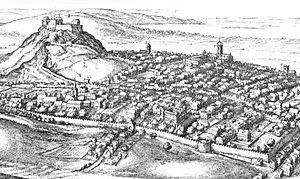Whiggamore Raid facts for kids
Quick facts for kids Whiggamore Raid |
|||||||
|---|---|---|---|---|---|---|---|
| Part of the Scottish Civil War | |||||||
 Engraving of Edinburgh by Wenceslaus Hollar, 1670 |
|||||||
|
|||||||
| Belligerents | |||||||
| Commanders and leaders | |||||||
The Whiggamore Raid was a march by a group called the Kirk Party. They were part of the Covenanters, a Scottish religious and political movement. In September 1648, they marched on Edinburgh, the capital of Scotland. Their goal was to take control from another group called the Engagers. The Engagers' army had just lost a big battle to the English New Model Army.
The name "Whiggamores" was a nickname for the Kirk Party. It likely came from a Scots word for "mare drivers." Later, this name was shortened to "Whigs". The Kirk Party was against an agreement called "the Engagement" that the Engagers had made with King Charles I.
Background to the Raid
After the Battle of Preston (1648) in August 1648, the Duke of Hamilton's army was defeated. However, two other commanders, Sir George Monro and Sir Philip Musgrave, still had about 7,000 soldiers. Monro and his English allies were not getting along well. So, Monro marched his forces back to Scotland. He crossed the border on September 8, 1648. Musgrave's forces were left behind and later surrendered.
Meanwhile, the Earl of Lanark and the Committee of Estates were worried. They did not want Oliver Cromwell, the English general, to follow the defeated armies into Scotland. They ordered that no English soldiers who had fought with Hamilton or Monro should be allowed into Scotland. Cromwell was moving north, but he soon found allies within Scotland itself.
The Raid on Edinburgh
Archibald Campbell, 1st Marquess of Argyll saw the Engagers' defeat as a chance to regain his own power. Presbyterian ministers across Scotland supported him. In the west of Scotland, Robert, Lord Eglinton, gathered strong Presbyterians. These people were known in Edinburgh as Whiggamores. This name supposedly came from the cry "Whiggam!" they used to encourage their horses.
A large group of mostly unarmed farmers and common people joined Alexander, Earl of Eglinton. This march was given the name "Whiggamore Raid." They had a lot of public support. They easily took control of Edinburgh. Old Leven helped them secure Edinburgh Castle. David Leslie, a military leader, joined Argyll's side. The Chancellor, Loudoun, also left the Committee of Estates to support Argyll.
What Happened Next
The Committee of Estates was forced out of Edinburgh. They went to Stirling, seeking protection from Monro's army. But the Whiggamores followed them. There was a small fight, or skirmish, at Stirling on September 12, 1648.
Lanark and Monro's officers wanted to fight the Whiggamores. They thought it would be easy to win against such a mixed group. However, the Committee of Estates knew they didn't have much support. Both sides also worried that English forces might attack Scotland while they were divided. So, they decided to talk instead of fight.
On September 26, the Committee of Estates gave up their control of the government. It was agreed that Sir George Monro's soldiers would return to Ireland. Also, anyone who had supported the Engagement had to give up their official positions in Scotland.
See also
- British Whig Party
- Liberal Party (UK)
- Patriot Whigs or Patriot Party
- Radical Whigs

